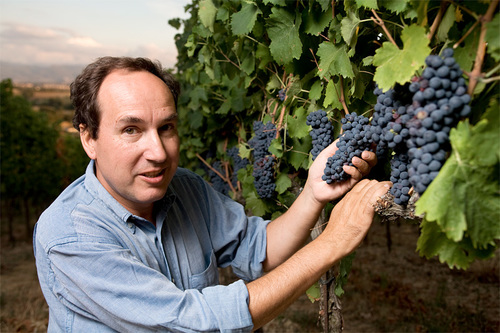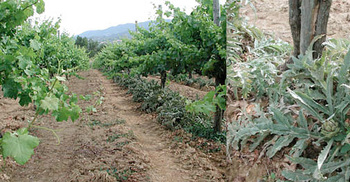| « Previous | News | Next » |
January 19, 2016
Umbria: The Green Heart of Italy
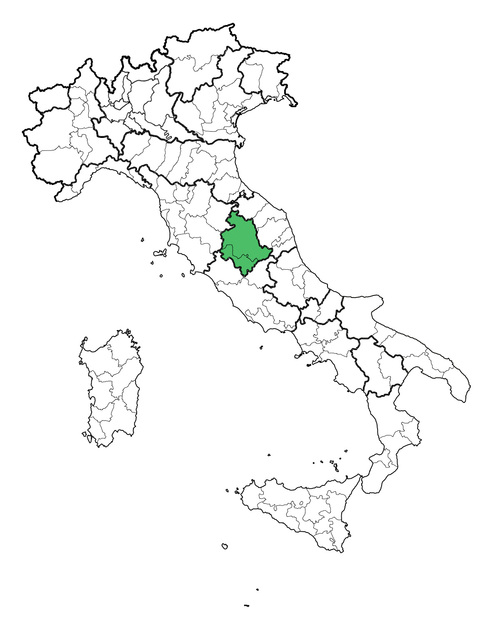 Known to locals as Italy’s “green heart,” Umbria is lush and peaceful, filled with medieval villages, undulating hills, and olive groves. It’s so laidback, in fact, that its wine often gets upstaged by Tuscany, which lies just north. True, it’s the fourth smallest wine region in the country, while Tuscany churns out five times the amount of wine. But don’t let its small size fool you. The wine in Umbria is idiosyncratic, age-worthy, and altogether on point. Umbria is home to several distinctive varietals, as well as a host of dynamic producers committed to natural winemaking, a variety of great soils (tufa, clay, volcanic rock), and a pastoral landscape. It may be lesser known among Italy’s regions, but it truly delivers to those lucky enough to seek it out.
Known to locals as Italy’s “green heart,” Umbria is lush and peaceful, filled with medieval villages, undulating hills, and olive groves. It’s so laidback, in fact, that its wine often gets upstaged by Tuscany, which lies just north. True, it’s the fourth smallest wine region in the country, while Tuscany churns out five times the amount of wine. But don’t let its small size fool you. The wine in Umbria is idiosyncratic, age-worthy, and altogether on point. Umbria is home to several distinctive varietals, as well as a host of dynamic producers committed to natural winemaking, a variety of great soils (tufa, clay, volcanic rock), and a pastoral landscape. It may be lesser known among Italy’s regions, but it truly delivers to those lucky enough to seek it out.
Orvieto is the DOC that gets the most shelf space in the U.S., but the town of Montefalco in the province of Perugia is perhaps more exciting, making head-turning wines from native Sagrantino and Grechetto grapes. Nicknamed “Umbria’s balcony” for its high perch overlooking the rolling hills of the area, this is ground zero for serious Umbrian juice. Sagrantino is a very tannic and flavorful red grape dating back to at least the 16th century in Montefalco, “regularly compared with Brunello in its aromatics and with Barolo in tannic grip,” according to Jancis Robinson. It’s small-berried and thick-skinned, so it can go wrong—or really, really right—depending on what happens in the vineyard. The sunny, Mediterranean climate of Umbria is important here, as the grape needs to reach perfect phenolic ripeness for the wine to be balanced.
Antonelli San Marco is an old-school producer who has made Sagrantino into an art form. The estate has been around since Medieval period, and has been in the hands of the Antonelli family since the 19th century (current owner Filippo Antonelli is pictured above). All the grapes are farmed organically, estate grown, and harvested by hand. They do not use new barriques, but rather the traditional large Slovenian barrels. Their wines are carefully crafted to bring out the best in their grapes, while reflecting the character of Montefalco.
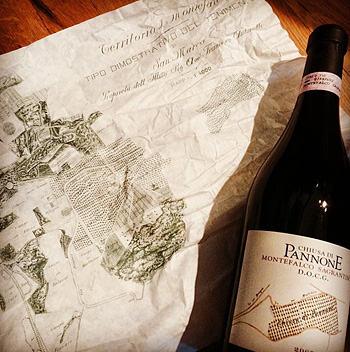 For an introduction to the reds of the region, try their 2011 Montefalco Rosso, a blend of 70 percent Sangiovese, 15 percent Sagrantino, and 15 percent Merlot. It has a muscular structure with fine tannins that promise a long, long life. The aromatics balance the brawn, with cherry, pine, sage, leather, rose, and gardenias on the nose leading to a fresh cherry and plum palate. This could lay down for another 5 years, but if you can’t wait, decant it before you drink it. To jump with both feet into Sagrantino, do yourself a favor and try the 2007 Sagrantino di Montefalco “Chiusa di Pannone.” It is perfectly ready to drink, though it still has enough youth for decades. (Decanter confirms: “Sagrantino is a tough, small-berried grape characterized by large pips and a thick skin, which gives it its tannic structure. It averages 14% alcohol, meaning in good years it can age up to 25 years and over.” And 2007 was an exceptional vintage in Umbria.) The tannins are supple and the palate is rich. It’s a deep garnet in glass, with notes of sour cherries, kirsch, mocha, chocolate, and espresso.
For an introduction to the reds of the region, try their 2011 Montefalco Rosso, a blend of 70 percent Sangiovese, 15 percent Sagrantino, and 15 percent Merlot. It has a muscular structure with fine tannins that promise a long, long life. The aromatics balance the brawn, with cherry, pine, sage, leather, rose, and gardenias on the nose leading to a fresh cherry and plum palate. This could lay down for another 5 years, but if you can’t wait, decant it before you drink it. To jump with both feet into Sagrantino, do yourself a favor and try the 2007 Sagrantino di Montefalco “Chiusa di Pannone.” It is perfectly ready to drink, though it still has enough youth for decades. (Decanter confirms: “Sagrantino is a tough, small-berried grape characterized by large pips and a thick skin, which gives it its tannic structure. It averages 14% alcohol, meaning in good years it can age up to 25 years and over.” And 2007 was an exceptional vintage in Umbria.) The tannins are supple and the palate is rich. It’s a deep garnet in glass, with notes of sour cherries, kirsch, mocha, chocolate, and espresso.
For whites, try the 2013 Antonelli “Trebium” Trebbiano Spoletino. Trebbiano Spoletino is not to be confused with Trebbiano Toscano (secrets of the Trebbiano family), the lackluster white grape that gave Chianti a bad name in the sixties when it was a mandatory part of its blend. The Spolentino grape has much more character, which you’ll note in this wine. It’s bright and shiny like a diamond ring. There are green apple, stony, and lemony notes tied together with mouth-wateringly high acid. It has a silky medium body with hint of salinity on the finish. The 2014 vintage was awarded Tre Bicchieri from Gambero Rosso.
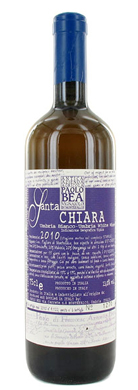 The white Grechetto grape is perhaps the yin to Sagrantino’s yang. Full-bodied and nutty, it is another quirky native to the region. Paolo Bea, an iconic producer with a cult following, produces a beguiling example in his 2012 “Santa Chiara” Umbria Bianco, a blend of Grechetto, Malvasia, Chardonnay, Sauvignon Blanc, and Garganega. In the glass, it’s a magnificent orange-gold color, reminiscent of Grand Marnier and marigolds. The color is thanks to the two weeks that the grapes spent macerating on their skins. On the nose, there are notes of honey, menthol, flowers, and almonds, opening into a slightly nutty and oxidized style. Baked pear and marzipan show on the minerally, lush palate, leading to a very dry finish. It rounds out with air, but always stays dry as a bone. The wine was left on its lees for a whole year before bottling and the complexity imparted by this technique is apparent.
The white Grechetto grape is perhaps the yin to Sagrantino’s yang. Full-bodied and nutty, it is another quirky native to the region. Paolo Bea, an iconic producer with a cult following, produces a beguiling example in his 2012 “Santa Chiara” Umbria Bianco, a blend of Grechetto, Malvasia, Chardonnay, Sauvignon Blanc, and Garganega. In the glass, it’s a magnificent orange-gold color, reminiscent of Grand Marnier and marigolds. The color is thanks to the two weeks that the grapes spent macerating on their skins. On the nose, there are notes of honey, menthol, flowers, and almonds, opening into a slightly nutty and oxidized style. Baked pear and marzipan show on the minerally, lush palate, leading to a very dry finish. It rounds out with air, but always stays dry as a bone. The wine was left on its lees for a whole year before bottling and the complexity imparted by this technique is apparent.
Paolo Bea, along with his sons Giampiero and Giuseppe, has earned such a following because his wines are excellent: well-made and ponderous. He uses a biodynamic, biodiverse approach to farming—no machines in the vineyard, only horses and hands. In addition to wine, the estate grows all the food that supports the family, including olives, fruit, vegetables, grain, and animals. With the family dating back to the 1500s in Montefalco, the Beas are heavily rooted in history and tradition. Paolo is one of the founders of ViniVeri, a group devoted to traditional, non-interventionist winemaking. And this credo nears religious devotion for the Beas: they never filter, use commercial yeasts, or use pesticides. They never intervene in any way that might sacrifice the most pure, fundamental flavor of the grapes.
The 2009 “San Valentino” Umbria Rosso (2010 vintage arriving spring 2016) is a blend of Sangiovese, Sagrantino, and Montepulciano, macerated on their skins for 30 days for deeper extraction. With a black-cherry color and a deep, brooding personality, it shows notes of tobacco, leather, cigar box, and spice. If asked for its sign, this wine would be a scorpio—complex and spirited. A rich palate of red fruits and violets leads to a dry finish. The tannins are firm, but the fruit lingers. It’s gorgeous in the mouth: supple, medium weight, buoyant. The aromas are delicate but the muscle is there. This will only improve with age.
In an interview in USA Today, Antonelli points out that Umbria, and especially Montefalco, offers a genuine experience. “Although our atmosphere is similar to Tuscany, Umbria is less crowded, less expensive, less spread out — and truly authentic.” (10/2014) And its wines reflect the ethos of the region: less touristy, more real, and deeply intriguing.
Article written by Kate Soto

